2024 AMC 8
Complete problem set with solutions and individual problem pages
What is the unit digit of:
- A.
- B.
- C.
- D.
- E.
Solution 1
We can rewrite the expression as . We note that the units digit of is because all the units digits of the five numbers are and , which has a units digit of . Now, we have something with a units digit of subtracted from , and so the units digit of this expression is .
Solution 2
We only care about the units digits. Thus, ends in , after regrouping(10-2) ends in , ends in , ends in , and ends in .
What is the value of this expression in decimal form?
- A.
- B.
- C.
- D.
- E.
We see that is ; simplifies to , which is ;
and simplifies to , which is ;
reveals
is .
Four squares of side length and are arranged in increasing size order so that their left edges and bottom edges align. The squares alternate in color white-gray-white-gray, respectively, as shown in the figure. What is the area of the visible gray region in square units?
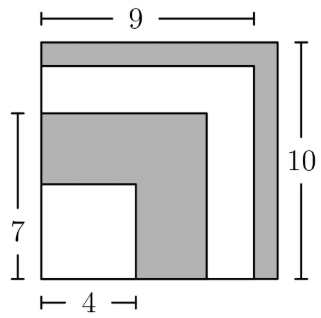
- A.
- B.
- C.
- D.
- E.
Solution 1
We work inwards. The area of the outer shaded square is the area of the whole square minus the area of the second largest square. The area of the inner shaded region is the area of the third largest square minus the area of the smallest square. The sum of these areas is
Solution 2
In solution 1, we can use Difference of squares to get the answer, rather than calculating the squares of the numbers:
When Yunji added all the integers from to , she mistakenly left out a number. Her incorrect sum turned out to be a square number. What number did Yunji leave out?
- A.
- B.
- C.
- D.
- E.
Adding numbers 1 through 9 gives us 45. This was her expected sum, but what she got was a perfect square. Since she got that perfect square sum by forgetting a number, that sum is less than 45. The square number right under 45 is 36. So 45 - 36 = 9. So the solution is E[9].
Aaliyah rolls two standard 6-sided dice. She notices that the product of the two numbers rolled is a multiple of . Which of the following integers cannot be the sum of the two numbers?
- A.
- B.
- C.
- D.
- E.
Solution 1
First, figure out all pairs of numbers whose product is 6. Then, using the process of elimination, we can find the following:
is possible:
is possible:
is possible:
The only integer that cannot be the sum is .
Solution 2
First, see that in order for the two numbers to have a product of 6, it must either have 6 as a factor or have factors that have a product of 6 (Notably ).
When we look at the answer choices, we see that answers all are more than 6, so they can all be added as a sum of 6. Answer works because , so 6 is the only answer choice that doesn't work. Thus, the answer is .
Sergai skated around an ice rink, gliding along different paths. The gray lines in the figures below show four of the paths labeled P, Q, R, and S. What is the sorted order of the four paths from shortest to longest?
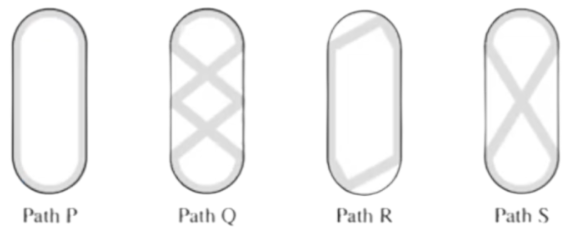
- A.
- B.
- C.
- D.
- E.
Solution 1
You can measure the lengths of the paths until you find a couple of guaranteed true inferred statements as such: is greater than , is greater than , and and are the smallest two, therefore the order is Thus we get the answer .
Solution 2
Obviously Path Q is the longest path, followed by Path S.
So, it is down to Paths P and R.
Notice that curved lines are always longer than the straight ones that meet their endpoints, therefore Path P is longer than Path R.
Thus, the order from shortest to longest is .
A rectangle is covered without overlap by 3 shapes of tiles: , , and , shown below. What is the minimum possible number of tiles used?

- A.
- B.
- C.
- D.
- E.
Solution 1
We can eliminate B, C, and D, because they are not subtracted by any multiple of . Finally, we see that there is no way to have A, so the solution is .
Solution 2
Let be the number of by tiles. There are squares and each by or by tile takes up 4 squares, so , so it is either or . Color the columns, starting with red, then blue, and alternating colors, ending with a red column. There are red squares and blue squares, but each by and by shape takes up an equal number of blue and red squares, so there must be more by tiles on red squares than on blue squares, which is impossible if there is just one, so the answer is , which can easily be confirmed to work.
On Monday, Taye has . Every day, he either gains or doubles the amount of money he had on the previous day. How many different dollar amounts could Taye have on Thursday, days later?
- A.
- B.
- C.
- D.
- E.
Solution 1
How many dollar values could be on the first day? Only dollars. The second day, you can either add dollars, or double, so you can have dollars, or . For each of these values, you have values for each. For dollars, you have dollars or , and for dollars, you have dollars or dollars. Now, you have values for each of these. For dollars, you have dollars or , for dollars, you have dollars or , for dollars, you have dollars or , and for dollars, you have dollars or .
On the final day, there are 11, 11, 16, and 16 repeating, leaving you with different values.
Solution 2
Continue as in Solution 1 to get , , or dollars by the 2nd day. The only way to get the same dollar amount occurring twice by branching (multiply by or adding ) from here is if or which both aren't true. Hence our answer is .
All the marbles in Maria's collection are red, green, or blue. Maria has half as many red marbles as green marbles, and twice as many blue marbles as green marbles. Which of the following could be the total number of marbles in Maria's collection?
- A.
- B.
- C.
- D.
- E.
Solution 1
Since she has half as many red marbles as green, we can call the number of red marbles , and the number of green marbles . Since she has half as many green marbles as blue, we can call the number of blue marbles . Adding them up, we have: marbles. The number of marbles therefore must be a multiple of , as represents an integer, so the only possible answer is
Solution 2
Suppose Maria has green marbles and total marbles. She then has red marbles and blue marbles. Altogether, Maria has
marbles, so so must be a multiple of . The only multiple of in the answer choices is
In January the Mauna Loa Observatory recorded carbon dioxide levels of ppm (parts per million). Over the years the average reading has increased by about ppm each year. What is the expected level in ppm in January ? Round your answer to the nearest integer.
- A.
- B.
- C.
- D.
- E.
Solution 1
This is a time period of years, so we can expect the ppm to increase by ppm. Since we started with ppm, we have .
Solution 2
years. The ppm level in 2030 is .
The coordinates of are , , and , with . The area of is 12. What is the value of ?
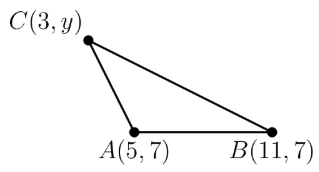
- A.
- B.
- C.
- D.
- E.
Solution 1
Since the triangle has a base of , we can plug in that value as the base. Then, we can solve the equation for the height. Doing so gives us,
This means that , so that means that we have to add 4 to the -coordinate. So the answer is
Solution 2
By the Shoelace Theorem, has area
From the problem, this is equal to . We now solve for y.
OR
OR
OR
However, since, as stated in the problem, , our only valid solution is .
Rohan keeps 90 guppies in 4 fish tanks.
- There is 1 more guppy in the 2nd tank than in the 1st tank.
- There are 2 more guppies in the 3rd tank than in the 2nd tank.
- There are 3 more guppies in the 4th tank than in the 3rd tank.
How many guppies are in the 4th tank?
- A.
- B.
- C.
- D.
- E.
Solution 1
Let denote the number of guppies in the first tank.
Then, we have the following for the number of guppies in the rest of the tanks:
- The number of guppies in the second tank is
- The number of guppies in the third tank is
- The number of guppies in the fourth tank is
The number of guppies in all of the tanks combined is 90, so we can write the equation
Simplifying the equation gives
Solving the resulting equation gives , so the number of guppies in the fourth tank is .
Solution 2
Suppose there are no guppies in the first tank. Then, the number of guppies in the other tanks are and or guppies in total. We need to add guppies into tanks or guppies in each tank, so the number of guppies in the fourth tank is
Buzz Bunny is hopping up and down a set of stairs, one step at a time. In how many ways can Buzz Bunny start on the ground, make a sequence of hops, and end up back on the ground? (For example, one sequence of hops is up-up-down-down-up-down.)
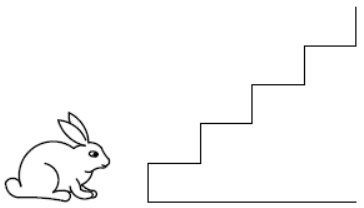
- A.
- B.
- C.
- D.
- E.
Solution 1
Looking at the answer choices, you see that you can list them out. Doing this gets you:
Counting all the paths listed above gets you .
Solution 2
Any combination can be written as some re-arrangement of . Clearly we must end going down, and start going up, so we need the number of ways to insert 2 's and 2 's into . There are ways, but we have to remove the case , giving us .
The one-way routes connecting towns and are shown in the figure below(not drawn to scale). The distances in kilometers along each route are marked. Traveling along these routes, what is the shortest distance from A to Z in kilometers?

- A.
- B.
- C.
- D.
- E.
Solution 1
We can simply see that path will give us the smallest value. Adding, . This is nice as it’s also the smallest value, solidifying our answer.
You can also simply brute-force it or sort of think ahead - for example, getting from A to M can be done ways; () or , so you should take the shorter route (). Another example is M to C, two ways - one is and the other is . Take the shorter route. After this, you need to consider a few more times - consider if () is greater than ), which it is not, and consider if ) is greater than () or () which it is not. TLDR: .
Solution 2
We can execute Dijkstra's algorithm by hand to find the shortest path from to every other town, including . This effectively proves that, assuming we execute the algorithm correctly, that we will have found the shortest distance. The distance estimates for each step of the algorithm (from to each node) are shown below:
The steps are as follows: starting with the initial node , set and for all where indicates the distance from to . Consider the outgoing edges and and update the distance estimates and , completing the first row of the table.
The node is the unvisited node with the lowest distance estimate, so we will consider and its outgoing edges and . The distance estimate equals , and the distance estimate updates to , because . This completes the second row of the table. Repeating this process for each unvisited node (in order of its distance estimate) yields the correct distance once the algorithm is complete.
Let the letters ,,,,, represent distinct digits. Suppose is the greatest number that satisfies the equation
What is the value of ?
- A.
- B.
- C.
- D.
- E.
Solution 1
The highest that can be would have to be , and it cannot be higher than that, because then it would be , and multiplied by 8 is , and then it would exceed the - digit limit set on .
So, if we start at , we get , which would be wrong because both would be , and the numbers cannot be repeated between different letters.
If we move on to the next highest, , and multiply by , we get . All the digits are different, so would be , which is . So, the answer is .
Solution 2
Notice that .
Likewise, .
Therefore, we have the following equation:
.
Simplifying the equation gives
.
We can now use our equation to test each answer choice.
We have that , so we can find the sum:
.
So, the correct answer is .
Minh enters the numbers through into the cells of a grid in some order. She calculates the product of the numbers in each row and column. What is the least number of rows and columns that could have a product divisible by ?
- A.
- B.
- C.
- D.
- E.
Solution 1
Note you can swap/rotate any configuration of rows, such that all the rows and columns that have a product of 3 are in the top left. Hence the points are bounded by a rectangle. This has area and rows and columns divisible by . We want and minimized.
If , we achieve minimum with .
If ,our best is . Note if , . Because , there is no smaller answer, and we get .
Solution 2
For a row or column to have a product divisible by , there must be a multiple of in the row or column. To create the least amount of rows and columns with multiples of , we must find a way to keep them all together, to minimize the total number of rows and columns with multiples of threes in it. From to , there are multiples of . So we have to fill cells with numbers that are multiples of . If we put of these numbers in a grid, there would be rows and columns ( in total), with products divisible by . However, we have numbers, so numbers still need to be put in the grid. If we put both numbers in the th column, but one in the first row, and one in the second row, (next to the by grid already filled), we would have a total of columns now, and still rows with products that are multiples of . Since , the answer is
A chess king is said to attack all the squares one step away from it, horizontally, vertically, or diagonally. For instance, a king on the center square of a x grid attacks all other squares, as shown below. Suppose a white king and a black king are placed on different squares of a x grid so that they do not attack each other (in other words, not right next to each other). In how many ways can this be done?
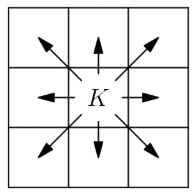
- A.
- B.
- C.
- D.
- E.
Solution 1
If you place a king in any of the corners, the other king will have spots to go and there are corners, so . If you place a king in any of the edges, the other king will have spots to go and there are edges so . That gives us spots for the other king to go into in total. So is the answer.
Solution 2
We see that the center is not a viable spot for either of the kings to be in, as it would attack all nearby squares.
This gives three combinations:
Corner-corner: There are 4 corners, and none of them are touching orthogonally or diagonally, so it's
Corner-edge: For each corner, there are two edges that don't border it,
Edge-edge: The only possible combinations of this that work are top-bottom and left-right edges, so for this type
Multiply by two to account for arrangements of colors to get .
Three concentric circles centered at have radii of , , and . Points and lie on the largest circle. The region between the two smaller circles is shaded, as is the portion of the region between the two larger circles bounded by central angles , as shown in the figure below. Suppose the shaded and unshaded regions are equal in area. What is the measure of in degrees?
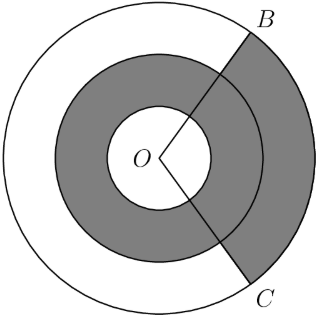
- A.
- B.
- C.
- D.
- E.
Solution 1
Let .
We see that the shaded region is the inner ring plus a sector of the outer ring. Using the formula for the area of a circle (), we find that the area of is . This simplifies to .
The unshaded portion is comprised of the smallest circle plus the sector of the outer ring, which evaluates to .
We are told these are equal. Therefore, . Solving for reveals .
Solution 2
Notice that for the 3rd most outer ring of the circle, the ratio of the shaded region to non-shaded region is the ratio of to . With that, all we need to do is solve for the shaded region.
The inner most circle has radius , and the second circle has radius 2. Therefore, the first shaded area has area. The circle has total area , so the other shaded region must have area, as the non-shaded and shaded area is equivalent. So for the 3rd outer ring, the total area is , so the non-shaded part of the outer ring is .
Now as said before, the ratio of these two areas is the ratio of and . So, . We have where , , so our answer is .
Jordan owns 15 pairs of sneakers. Three fifths of the pairs are red and the rest are white. Two thirds of the pairs are high-top and the rest are low-top. The red high-top sneakers make up a fraction of the collection. What is the least possible value of this fraction?

- A.
- B.
- C.
- D.
- E.
Solution 1
Jordan has high top sneakers, and white sneakers. We would want as many white high-top sneakers as possible, so we set high-top sneakers to be white. Then, we have red high-top sneakers, so the answer is
Solution 2
We first start by finding the amount of red and white sneakers. 3/5 * 15=9 red sneakers, so 6 are white sneakers. Then 2/3 * 15=10 are high top sneakers, so 5 are low top sneakers. Now think about 15 slots and the first 10 are labeled high top sneakers. if we insert the last 5 sneakers as red sneakers there are 4 leftover over red sneakers. Putting those four sneakers as high top sneakers we have our answer as C, or
Any three vertices of the cube , shown in the figure below, can be connected to form a triangle. (For example, vertices , , and can be connected to form isosceles .) How many of these triangles are equilateral and contain as a vertex?
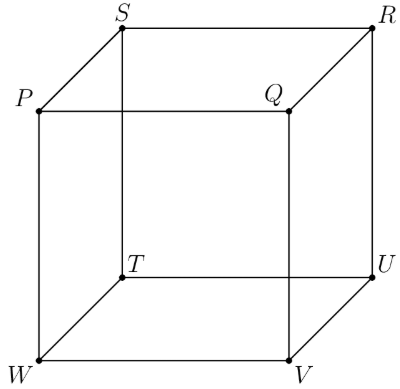
- A.
- B.
- C.
- D.
- E.
Solution 1
The only equilateral triangles that can be formed are through the diagonals of the faces of the square. From P you have possible vertices that are possible to form a diagonal through one of the faces. Therefore, there are possible triangles. So the answer is .
Solution 2
Each other compatible point must be an even number of edges away from P, so the compatible points are R, V, and T. Therefore, we must choose two of the three points, because P must be a point in the triangle. So, the answer is .
A group of frogs (called an army) is living in a tree. A frog turns green when in the shade and turns yellow when in the sun. Initially, the ratio of green to yellow frogs was . Then green frogs moved to the sunny side and yellow frogs moved to the shady side. Now the ratio is . What is the difference between the number of green frogs and the number of yellow frogs now?
- A.
- B.
- C.
- D.
- E.
Solution 1
Let the initial number of green frogs be and the initial number of yellow frogs be . Since the ratio of the number of green frogs to yellow frogs is initially , . Now, green frogs move to the sunny side and yellow frogs move to the shade side, thus the new number of green frogs is and the new number of yellow frogs is . We are given that , so , since , we have , so and . Thus the answer is
Solution 2
Since the original ratio is and the new ratio is , the number of frogs must be a multiple of , the only solutions left are and .
Let's start with frogs:
We must have frogs in the shade and frogs in the sun. After the change, there would be frogs in the shade and frog in the sun, which is not a ratio.
Therefore the answer is: .
A roll of tape is inches in diameter and is wrapped around a ring that is inches in diameter. A cross section of the tape is shown in the figure below. The tape is inches thick. If the tape is completely unrolled, approximately how long would it be? Round your answer to the nearest inches.

- A.
- B.
- C.
- D.
- E.
Solution 1
The roll of tape is layers thick. In order to find the total length, we have to find the average of each concentric circle and multiply it by . Since the diameter of the small circle is inches and the diameter of the large one is inches, the "middle value" (or mean) is .
Therefore, the average circumference is . Multiplying gives approximately .
Solution 2
There are about "full circles" of tape, and with average circumference of which means the answer is .
Rodrigo has a very large sheet of graph paper. First he draws a line segment connecting point to point and colors the cells whose interiors intersect the segment, as shown below. Next Rodrigo draws a line segment connecting point to point . How many cells will he color this time?

- A.
- B.
- C.
- D.
- E.
Let be the number of cells the line segment from to passes through. The problem is then equivalent to finding
Sometimes the segment passes through lattice points in between the endpoints, which happens times. This partitions the segment into congruent pieces that each pass through cells, which means the answer is
Note that a new square is entered when the lines pass through one of the lines in the coordinate grid, which for happens times. Because and are relatively prime, no lattice point except for the endpoints intersects the line segment from to This means that including the first cell closest to The segment passes through cells. Thus, the answer is Alternatively, can be found by drawing an accurate diagram, leaving you with the same answer.
Jean has made a piece of stained glass art in the shape of two mountains, as shown in the figure below. One mountain peak is feet high while the other peak is feet high. Each peak forms a angle, and the straight sides form a angle with the ground. The artwork has an area of square feet. The sides of the mountain meet at an intersection point near the center of the artwork, feet above the ground. What is the value of
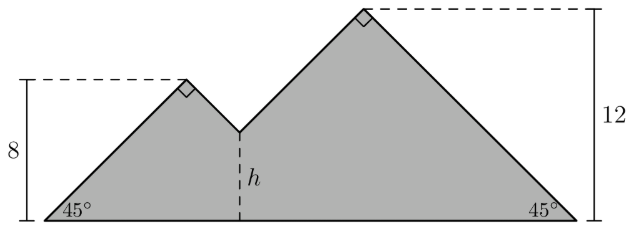
- A.
- B.
- C.
- D.
- E.
Extend the "inner part" of the mountain so that the image is two right triangles that overlap in a third right triangle as shown.
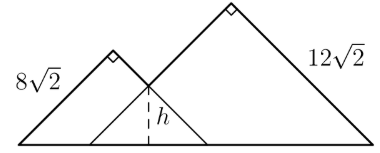
The side length of the largest right triangle is which means its area is Similarly, the area of the second largest right triangle is (the side length is ), and the area of the overlap is (the side length is ). Because the right triangles have a side ratio of 1:1:.Thus,
which means that the answer is
A small airplane has rows of seats with seats in each row. Eight passengers have boarded the plane and are distributed randomly among the seats. A married couple is next to board. What is the probability there will be 2 adjacent seats in the same row for the couple?
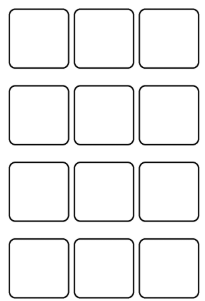
- A.
- B.
- C.
- D.
- E.
Solution 1
Suppose the passengers are indistinguishable. There are total ways to distribute the passengers. We proceed with complementary counting, and instead, will count the number of passenger arrangements such that the couple cannot sit anywhere. Consider the partitions of among the rows of seats, to make our lives easier, assuming they are non-increasing. We have .
For the first partition, clearly, the couple will always be able to sit in the row with occupied seats, so we have cases here.
For the second partition, there are ways to permute the partition. Now the rows with exactly passenger must be in the middle, so this case generates cases.
For the third partition, there are ways to permute the partition. For rows with passengers, there are ways to arrange them in the row so that the couple cannot sit there. The row with passenger must be in the middle. We obtain cases.
For the fourth partition, there is way to permute the partition. As said before, rows with passengers can be arranged in ways, so we obtain cases.
Collectively, we obtain a total of cases. The final probability is .
Solution 2
Suppose the passengers are indistinguishable.
What this question is asking, is really, if 4 empty seats are placed, what is the probability that there are 2 adjacent seats open.
We proceed by casework.
Case 1: There is exactly one pair of open seats. Then the other seat in that row must be occupied. The other two empty seats are distributed across the remaining rows without being adjacent, which is cases per pair of open seats for total cases.
Case 2: There is one row of open seats. ways to choose the row and to choose the final empty seat for cases.
Case 3: There are independent pairs of open seats. Choose the rows, then the placement of each pair within each row for cases.
In total, we get cases total for a probability of
- 1
- 2
- 3
- 4
- 5
- 6
- 7
- 8
- 9
- 10
- 11
- 12
- 13
- 14
- 15
- 16
- 17
- 18
- 19
- 20
- 21
- 22
- 23
- 24
- 25
